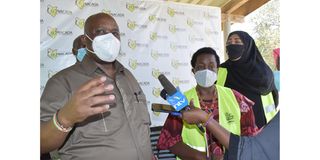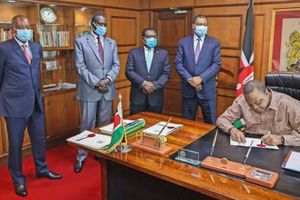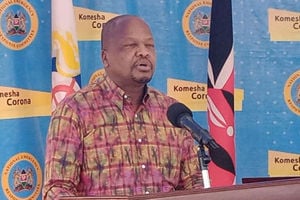Nacada: Drug abuse in schools has gone up

Nacada CEO Victor Okioma, board chairperson Mabel Imbuga and director Faridah Rashid at a past event in Mombasa.
Children as young as four are using alcohol and other substances, a recent report by the National Authority for the Campaign Against Alcohol and Drug Abuse (Nacada) shows.
The report, already in Parliament, blames the exposure of children to liquor and drugs to poor parenting.
More alarming is the fact that primary and secondary school children can easily get the drugs, contributing to riots and other criminal behaviour.
According to the report, the number of children abusing drugs in school could even be higher, given the low reporting.
It says children whose parents or guardians consume drugs or alcohol are more likely to become users themselves.
“This data reveals an overwhelming knock-on effect of parental use and exposure of their children to drug and substance abuse,” the report, signed by Nacada chief executive Victor Okioma, says.
The revelations come as the government pushes for amendments to the Narcotics, Drugs and Psychotropic Substances (Control) Act to impose punitive punishment on traffickers.
State authorities want them fined up to Sh50 million and given life imprisonment.
The Bill, sponsored by Nacada, also targets law enforcers who collude with traffickers to defeat the cause of justice.
It does not spare manufacturers of substances used as raw material for the drugs.
To improve on reporting, Nacada will continuously train data officers.
Not drug-free
According to the 2019 national survey on the status of drugs and substance abuse among secondary school students in Kenya, conducted by Nacada, the institutions are no longer drug-free.
The data on lifetime or ever use of the drugs and substances showed that 508,132 or 23.4 per cent of secondary school students have experimented on drugs or liquor.
Some 369,155 students, or about 17 per cent, reported to have used miraa, with 349,613 or 16.1 per cent having used prescription drugs.
The report shows that 314,869 or 14.5 per cent of the high school students have used tobacco, some 162,863 or 7.5 per cent have used cannabis and 50,000 or 2.3 per cent have inhaled glue, thinner or petrol.
It says 26,058 of schoolgoing children, or 1.2 per cent, have used heroin while 23,887 or 1.1 per cent, have tried cocaine.
Data on primary school children conducted in 2018 shows that 20.2 per cent have used at least one drug or substance of abuse.
About 10.4 per cent have used prescription drugs, some 7.2 per cent have consumed alcohol, about six per cent have used tobacco, around 3.7 per cent have consumed miraa or muguka while 1.2 per cent have smoked cannabis.
The lifetime use of inhalants, heroin and cocaine among primary school pupils is less than one per cent though the number could rise due to increased exposure by their parents or guardians.
“The study underscores the importance of strong parental relationship, attachment and control in protecting children against drugs,” the report says.




